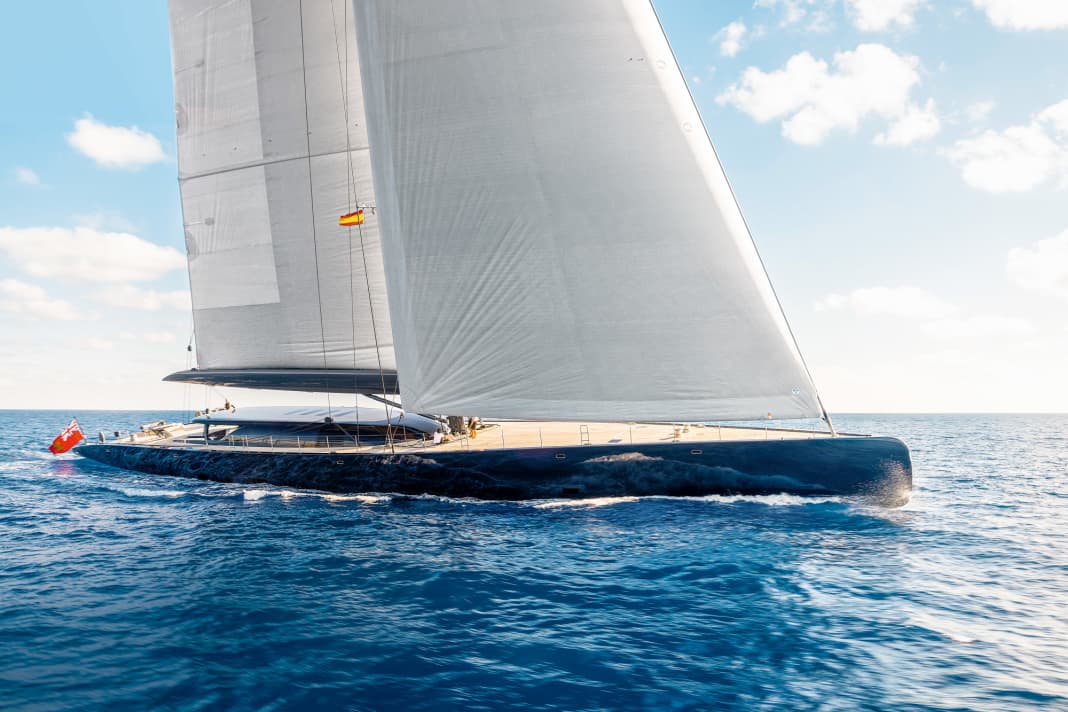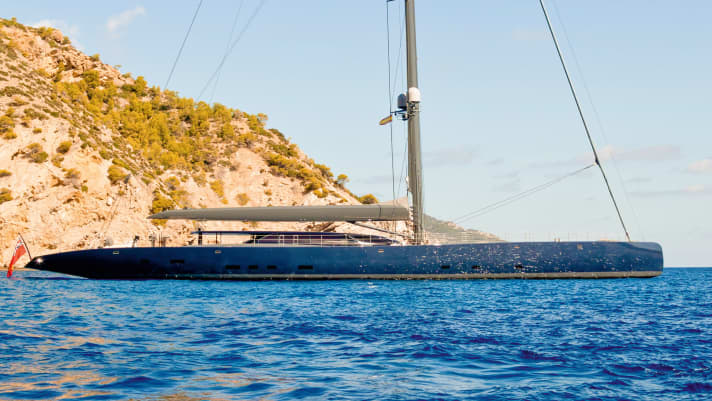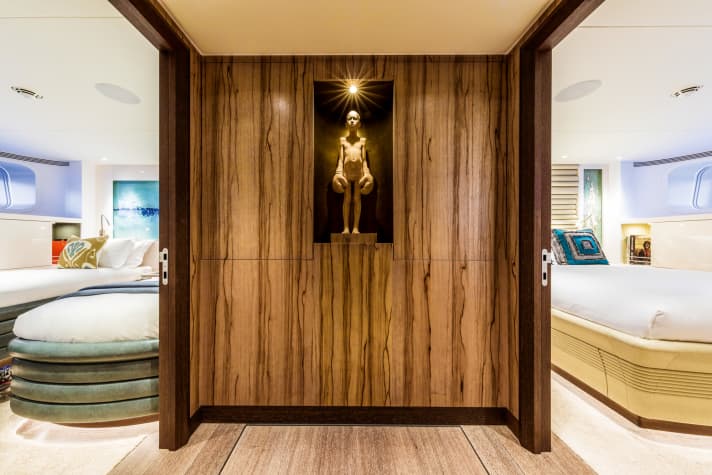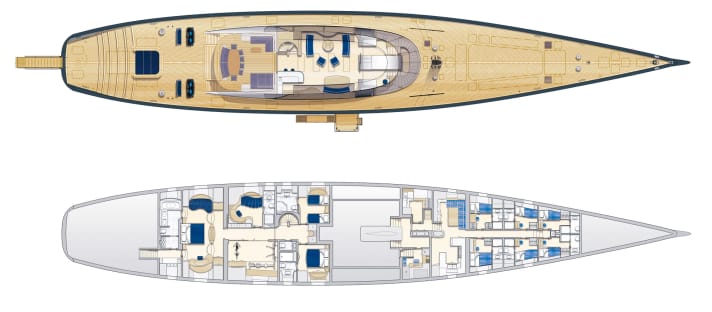58-metre slup from Royal Huisman: "Ngoni" is for sale for 45 million euros






Wolves confuse their prey by circling their victim over a wide area. After all, it no longer knows from which direction the threatening scent is coming and from where an attack can be expected. And then the wolves strike. "I don't want a wolf in sheep's clothing," the first owner had made the maxim of his desired "Ngoni" design. Which could only mean that he wanted a wolf in wolf's clothing, "an innovative weapon" to strike at sea. He likes to be at the helm himself, bringing Fastnet and Sydney Hobart experience to the wheel. The codename "The Beast" gave rise to many exciting speculations during the construction period.
Royal Huisman's construction was finally delivered in 2017, and now the "Ngoni" is ready to go for sale again at Y.CO. The call is for 45 million euros. Our sister magazine BOOTE EXCLUSIV was on board in 2018 and presented the Slup.
Wanted: a fresh look
The team around the first owner asked three designers for suggestions, including Ed Dubois. The owner looked at the designs three months later and sent Dubois back to the drawing board with the comment that he could do better: "Beautiful, but a tad too ordinary." First of all: Ed Dubois did not live to see the completion of his last project; in 2016, the Briton, born in 1952, lost his battle against an illness that he thought he had conquered.
Beautiful, but a tad too ordinary." - Owner's reaction to the first designs by Ed Dubois
However, the grand seigneur of large performance slips ("Kokomo", "Mondango", "Twizzle") already made his comments on the "Ngoni" order during his lifetime. "The owner had approached me because he wanted a fresh look in yacht design. He was familiar with my large performance yachts, but wanted me to return to my roots from the 70s and early 80s." Dubois, who had started his career as a designer with racing yachts and only then - "like Frers and Briand" - drew fast large yachts, sat back down in the studio and went back to his earlier racing designs. "I restarted my inner computer and focussed on weight saving and strength of construction."
A Slup is like a bow and arrow
According to Dubois, the concept of a Slup follows the principle of a bow and arrow. The hull corresponds to the bow, the mast to the arrow and the fore and backstays are the string. The pressure on the string can be absorbed with a strong and deep torso width. "Ngoni", however, is rather slender with a low freeboard. A structurally weak superstructure and holes in the deck for the tender, skylights and sails would not exactly improve the strength of the construction. A strong deck plate of 35 millimetres could only compensate a little. "That's how I came up with the reverse leap."
The complex structural analysis in the computer confirmed an increase in strength of twelve per cent with the same material weight. Dubois was aware of the risk that the owner might not agree with this unusual look. "However, the owner wanted a yacht with bite that would also function as a world cruiser." Dubois inevitably had to move away from convention. "When I met the owner in London, I showed him the drawing. He was thrilled and even gave me a big hug." The convex hull also makes it easier to see from the cockpit. Despite the spacious deckhouse, "Ngoni" does not have a flybridge. The owner loves being close to the water.

A distortion-free curved glazing of several elements, tinted and moulded in a hollow, made in Turkey, also provides an unobstructed view of the sea.
Ed Dubois also created the layout below deck of the "Ngoni"
In addition to racer components, Dubois also used plans for the superstructure of his 66-metre-long Vitters slup "Aglaia" (now "Ahimsa"). Last but not least, the design concept of the construction also influences the interior. "As architects, we know where the mast, keel box and engine compartment belong." On a sailing yacht in particular, these elements have fundamental consequences for the interior design. "I like to take care of that." It also depends on the owner's lifestyle, "what they like on board - or can only tolerate". This is why Dubois also developed the layout of the main and lower decks, bringing curves into play as the basis for the interior design, which Baker and Morgan were able to build on.
When it comes to the interior, the concept of comfort plays a role, and this often clashes, albeit not as aggressively as a wolf, with the demand for speed. Dubois did not like to hear that a compromise had to be made here. "I prefer the term balance." To achieve this, you have to look at the intended use and the benefits from the owner's perspective. But how do you find the balance? What does the owner really want? "That's not always easy to say. Some have very clear ideas, others less so." The experienced "Ngoni" owner was easy to assess.
However, designers who have never sat on the high edge of a self-designed boat for hours in the weather, never experienced cold and possibly fear, victory and defeat, have never learnt how a boat reacts under all the conditions of a regatta course. The material of the construction also contributes to these reactions. At the very beginning of the "Ngoni" briefing, the question was whether a carbon fibre hull was an option. "The owner wanted to play through all the options. We presented him with comparisons in terms of weight, costs and construction time." Carbon fibre would have been lighter and stronger, but less comfortable for long journeys around the world. "Carbon hulls react with aggressive movements at sea." They are not so sea-friendly, promote seasickness and tend to be very loud. As a result, any weight saved is lost on board via acoustic insulation. Professionally weighing up the pros and cons of materials is like solving a complicated equation. "The owners trust you and pay you precisely for these skills."
Royal Huisman built the "Ngoni", Baker and Morgan fitted it out
Once the decision for an aluminium construction had been made, the owner still had to choose the shipyard. This was somewhat easy for him, as his yacht before "Ngoni", the 40 metre long Dixon ketch "Antares", had also slipped out of the halls of Royal Huisman in 2005.
The commission for the interior design inevitably went to Rick Baker and Paul Morgan. In addition to designing the interior, the partners Baker and Morgan also offer the complete manufacture of the furniture they have designed themselves and the installation for individual orders through the London-based Rick Baker Ltd. However, it was at least as decisive that they have been realising the owner's interior design wishes on land for over 20 years.
We wanted to avoid a hotel feel at all costs."
Rick Baker studied illustration and fine art, Paul Morgan has a background in architecture. "Ngoni" was their yacht première. The two of them threw themselves wholeheartedly into an unmistakable non-concept: "We deliberately avoided giving the interior a theme. Instead, we chose very individual solutions for the different areas. We wanted to avoid a hotel feel and repetition in the cabins at all costs."

2,000 square metres of sail, 70 metres of mast, 73 tonnes of ballast
High-gloss paint and valuable hardwoods would have been expected. "Instead, we chose very specialised finishes that no one would associate with a modern yacht." London-based Officina Coppola supplied panels and doors in resin, metal and lime with visual effects reminiscent of looking into shallow waters. Baker and Morgan embedded these details and their ideas in an organic and sweeping design language.
The regatta-trained owner showed conservative tendencies despite his inclination towards innovation. On a yacht of this size, nobody would expect direct mechanical steering with a quadrant instead of hydraulics. However, Royal Huisman succeeded in reducing the large frictional torques and rudder pressure produced by a single rudder blade and a rig with a mast over 70 metres long. A lead bomb with 73 tonnes of ballast is suspended from the steel fin of the lift keel to balance a sail area of almost 2,000 square metres on the wind, all easily steered mechanically thanks to Dubois' Genius.
And the strange name "Ngoni"?
Looks African, is African and for this reason alone has nothing to do with a wolf. The word comes from West Africa and refers to a stringed instrument similar to a lute, with three or four strings. The musician winds the strings over a resonating body with stretched skin. And Africans traditionally give this body the shape of the hull of a boat.
Technical data "Ngoni"

- Length over everything: 58,15 m
- Waterline length: 51,20 m
- Width: 9,54 m
- Depth:5,30/8,10 m
- Displacement:353 t
- Gross tonnage: 396
- Material: Alustar
- Rig: Rondal/Carbo-Link
- Mast height:75 m
- Sail: North 3Di
- Sail area (on the wind): 1,950 square metres
- Sail area (outhaul): 3,093 square metres
- Motor: MTU 8V 2000 M72
- Engine power:720 kW
- Fuel:30.300 l
- Range: 4,000 nm @ 12 kn
- Water: 10.000 l
- Front/rear spotlights: Hydrosta
- Navigation:B&G, Furuno
- Communication:Sailor
- Entertainment:Kaleidescape
- Design: Dubois Naval Architects
- Interior design: Rick Baker Ltd.
- Shipyard: Royal Huisman, 2017

